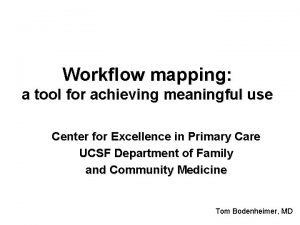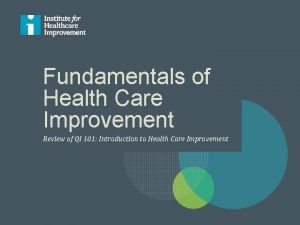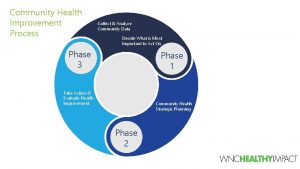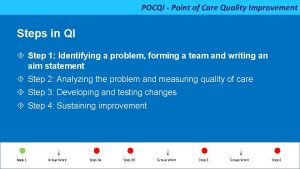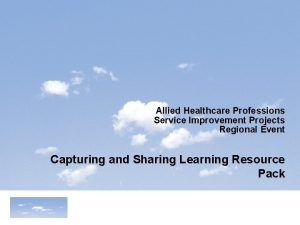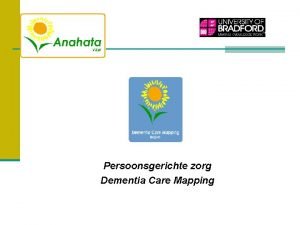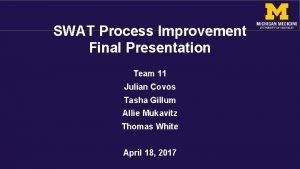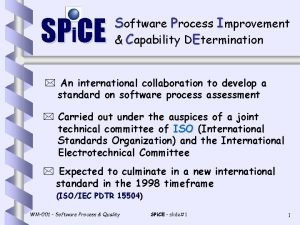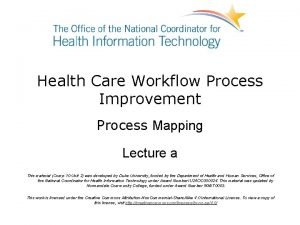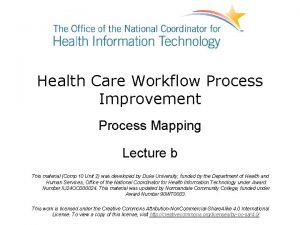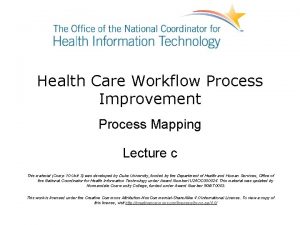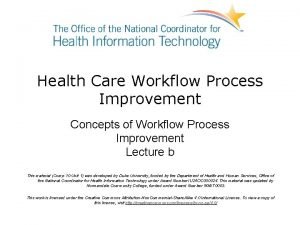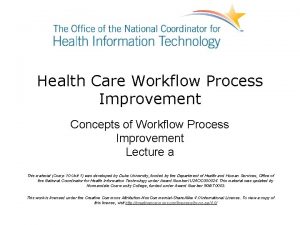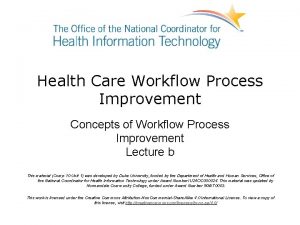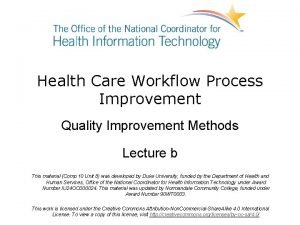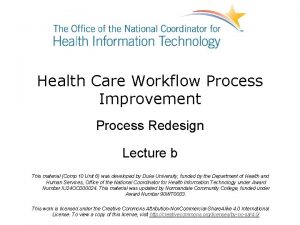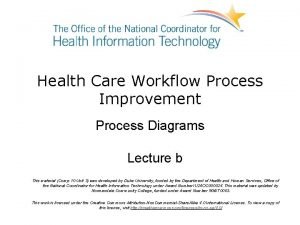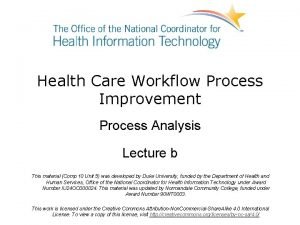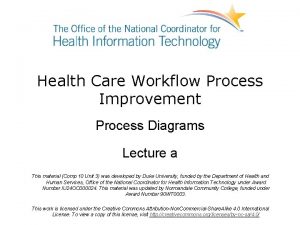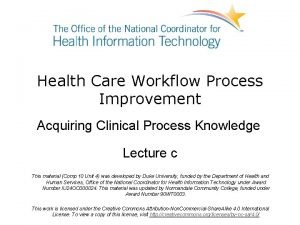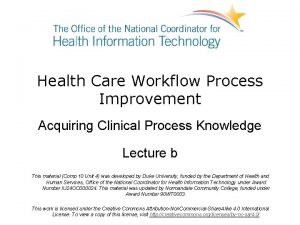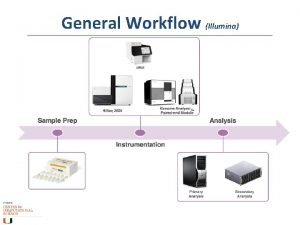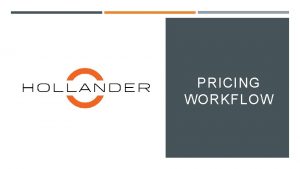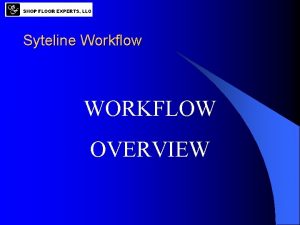Health Care Workflow Process Improvement Process Mapping Lecture





















- Slides: 21

Health Care Workflow Process Improvement Process Mapping Lecture d This material (Comp 10 Unit 3) was developed by Duke University, funded by the Department of Health and Human Services, Office of the National Coordinator for Health Information Technology under Award Number IU 24 OC 000024. This material was updated by Normandale Community College, funded under Award Number 90 WT 0003. This work is licensed under the Creative Commons Attribution-Non. Commercial-Share. Alike 4. 0 International License. To view a copy of this license, visit http: //creativecommons. org/licenses/by-nc-sa/4. 0/

Process Mapping Learning Objectives • Read and interpret Gane-Sarson data flow diagram 2

Process Mapping Lecture d - Topics • Gane-Sarson symbols and conventions for process mapping • Reading Gane-Sarson data flow diagrams 3

Methods for Diagramming Processes Table 3. 4 Methods for Diagramming Processes. Nahm, M, 2012. 4

Background • Gane-Sarson notation was introduced in Chris Gane and Trish Sarson’s 1977 book Structured Systems Analysis: Tools and Techniques • Gane-Sarson notation is used for data flow diagrams 5

Use Gane-Sarson data flow diagrams show – Movement – Transformation – Storage of data 6

Simplified On-line Appointment Scheduling Example 7

Gane-Sarson Symbols • Double square • Rounded rectangle • Arrow • Open-ended rectangle Symbols used for Gane-Sarson 8

Entities • Entities – Represent people, organizations, or other things that interact with the system – Send or consume information • If the same entity is shown more than once in a diagram, a diagonal line is added to the lower right-hand corner to visually distinguish it 9

Process 1 Assess patient • Processes transform data • Process should be named or described with: – Single word (a verb) – Phrase – Simple sentence o Describing what the process does • Similar to other notations, a good name will generally consist of a verb-object phrase such as check availability • In some cases, the processes are named for a role, an organization, or a machine that performs the process 10

Flow prescription • A data flow is a pipe through which data travel • Straight lines indicate flow or movement of information • Flow names indicate the meaning of the data that moves along the flow • Flow can: Represent only one type of data, e. g. , request or reply , OR – Consolidate several elementary data flows into one flow, – o Request and reply • The same content may have a different meaning in different parts of the system • Every line needs an arrow head to indicate direction of the data flow 11

Data Store EMR • Collection of data at rest • Can be in computerized or noncomputerized format • Stores are passive – Processes put data in or read data D 1 Claims database 12

Entities Instead of Event List • Gane-Sarson notation does not use event lists • Things that stimulate action from a system are indicated by entities 13

Diagram Levels • Diagram levels are – Roll-up and drill-down – Functional decomposition is used to represent each process in more detailed steps / processes • Context diagram is highest level • As many lower-levels as needed 14

Conventions • Meaningful names • Number processes and data stores • Make sure the DFD is internally consistent and consistent with any associated DFDs • Exceptions are shown on lower-level diagrams 15

Conventions (continued) • Size of the shapes should be consistent throughout the diagram – This limits the length of the name • Color shading for shapes and arrows may be used to visually show different – Entities – Processes – Data stores – Flows • Arrows in Gane-Sarson are straight and horizontal or vertical 16

Rules for Correctness • Entities may not – Send data directly to other entities – Send data directly to data stores – Get data directly from data stores • No spontaneous data creation • No black holes 17

Maintenance • Gane-Sarson is a set of symbols and conventions named for the people who developed it. • There is no formal maintenance organization. • Individuals use and adapt it to suit their needs. 18

Process Mapping Summary – Lecture d • Gane-Sarson symbols and conventions for process mapping • Reading Gane-Sarson data flow diagrams 19

Process Mapping References – Lecture d References Gane, C. , & Sarson, T. (1979). Structured Systems Analysis: Tools and Techniques. Englewood Cliffs, NJ: Prentice Hall. Ken Hopkins, Curriculum Council – Suggested Standards for Information Systems 2006: 238/7, Newman College, 2001. Retrieved from Newman College Website Information Systems Teachers, Consensus Meetings 2005. (eds. ). 2006, January). INFORMATION SYSTEMS, Suggested Standards for Information Systems Tools (Year 12 E 238/7 R). Retrieved from Trinity College Website Charts, Tables, Figures 3. 4 Table. Methods for diagramming processes. Nahm, M, Duke University, 2012. Images Slide 7: Simplified on-line appointment scheduling example using Gane-Sarson notation. Nahm M. , Duke University, 2012. Slide 8: Gane-Sarson symbols. Nahm M. , Duke University, 2012. Slide 9: Entities symbol in Gane-Sarson notation. Nahm M. , Duke University, 2012. Slide 10: Process symbol in Gane-Sarson notation. Nahm M. , Duke University, 2012. Slide 11: Flow symbol in Gane-Sarson notation. Nahm M. , Duke University, 2012. Slide 12: Data Store symbols in Sane-Garson notation. Nahm M. , Duke University, 2012. 20

Process Mapping Lecture d This material was developed by Duke University, funded by the Department of Health and Human Services, Office of the National Coordinator for Health Information Technology under Award Number IU 24 OC 000024. This material was updated by Normandale Community College, funded under Award Number 90 WT 0003. 21
 Workflow process mapping for ehr implementation
Workflow process mapping for ehr implementation Qi 101: introduction to health care improvement
Qi 101: introduction to health care improvement Community health improvement process
Community health improvement process Community health improvement process
Community health improvement process 01:640:244 lecture notes - lecture 15: plat, idah, farad
01:640:244 lecture notes - lecture 15: plat, idah, farad Primary secondary and tertiary care
Primary secondary and tertiary care Memory parameters
Memory parameters Forward mapping vs backward mapping
Forward mapping vs backward mapping Transform mapping dan transaction mapping
Transform mapping dan transaction mapping Unit 2 equality diversity and rights
Unit 2 equality diversity and rights Health and social care component 3
Health and social care component 3 Pocqi
Pocqi Ohio state health improvement plan
Ohio state health improvement plan The allied health profession service improvement project
The allied health profession service improvement project The allied health profession service improvement project
The allied health profession service improvement project Kitwood methode
Kitwood methode Unified health management information system
Unified health management information system Health economics lecture notes
Health economics lecture notes Ibm process improvement
Ibm process improvement Standard cmmi appraisal method for process improvement
Standard cmmi appraisal method for process improvement Swat process improvement
Swat process improvement Software process improvement and capability determination
Software process improvement and capability determination
